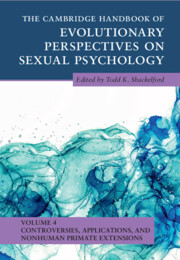Book contents
- The Cambridge Handbook of Evolutionary Perspectives on Sexual Psychology
- The Cambridge Handbook of Evolutionary Perspectives on Sexual Psychology
- Copyright page
- Contents
- Contributors
- Preface
- Part I Controversies and Unresolved Issues
- Part II Applications to Health, Law, and Pornography
- 6 Male Reproductive Health
- 7 Women’s Menstrual Cycles and Ovulation Provide Balanced Estradiol and Progesterone for Fertility and Lifelong Health
- 8 Female Genital Cutting
- 9 Costs of Polygyny
- 10 Male Sexual Disorders
- 11 An Evolutionary Perspective on Female Sexual Concerns and Dysfunctions
- 12 Evolutionary Perspectives on Male Sexual Offending
- 13 Pornography and Male Sexual Psychology
- Part III Nonhuman Primate Sexual Behavior
- Index
- References
10 - Male Sexual Disorders
from Part II - Applications to Health, Law, and Pornography
Published online by Cambridge University Press: 30 June 2022
- The Cambridge Handbook of Evolutionary Perspectives on Sexual Psychology
- The Cambridge Handbook of Evolutionary Perspectives on Sexual Psychology
- Copyright page
- Contents
- Contributors
- Preface
- Part I Controversies and Unresolved Issues
- Part II Applications to Health, Law, and Pornography
- 6 Male Reproductive Health
- 7 Women’s Menstrual Cycles and Ovulation Provide Balanced Estradiol and Progesterone for Fertility and Lifelong Health
- 8 Female Genital Cutting
- 9 Costs of Polygyny
- 10 Male Sexual Disorders
- 11 An Evolutionary Perspective on Female Sexual Concerns and Dysfunctions
- 12 Evolutionary Perspectives on Male Sexual Offending
- 13 Pornography and Male Sexual Psychology
- Part III Nonhuman Primate Sexual Behavior
- Index
- References
Summary
The main areas of male sexual disorders recognized by sexual medicine are paraphilic disorders and sexual dysfunctions This chapter offers an overview of the contributions of evolutionarily informed approach to the aetiology of male paraphilic disorders, with some space dedicated also to an evolutionary view of male sexual dysfunctions. First, the details of an evolutionary sexology (ES) approach are explained: (1) ES is relatively independent of current sexologic diagnoses. In contrast with the traditional medical and legal view, it is also independent of current sociocultural norms; (2) An advantage of ESis that symptoms themselves might be viewed as separate units of selection or parts of different complex evolutionarily relevant phenomena; (3) recent evolutionarily informed theories explain sexual disorders using a combination of nature and nurture reasoning; (4) ES combines the theoretical approach ofevolutionary psychology and ethology with knowledge of human phylogenetic history and selective pressures in the pleistocene environment of evolutionary adaptedness. An evolutionary framework views some male sexual disorders as adaptive behavioral strategies selected over evolutionary history because they increased the reproductive success of our ancestors, but they might also be viewed as maladaptive margins of the variability within the normophilic spectrum. A major part of the chapter is dedicated to evolutionary perspectives on paraphilic sexual interests (paraphilias) and disorders (according to current diagnostic manual (DSM-5, American Psychiatric Association [APA], 2013), the latter characterized by either paraphilia-related distress or antisocial behavior). Throughout the chapter, we distinguish between paraphilias and sexual offending. We provide evidence for the biological as well as developmental correlates of paraphilia and explain their possible placement in multidimensional sexual orientation space. We also summarize recent evidence on the prevalence of paraphilias in current populations. Finally, the dominant evolutionarily informed theories of the aetiology of common paraphilic interests and disorders (i.e., chronophilia, fetishism, nonconsent related paraphilias, and sadomasochism) and male sexual dysfunctions are described.
Keywords
- Type
- Chapter
- Information
- Publisher: Cambridge University PressPrint publication year: 2022



